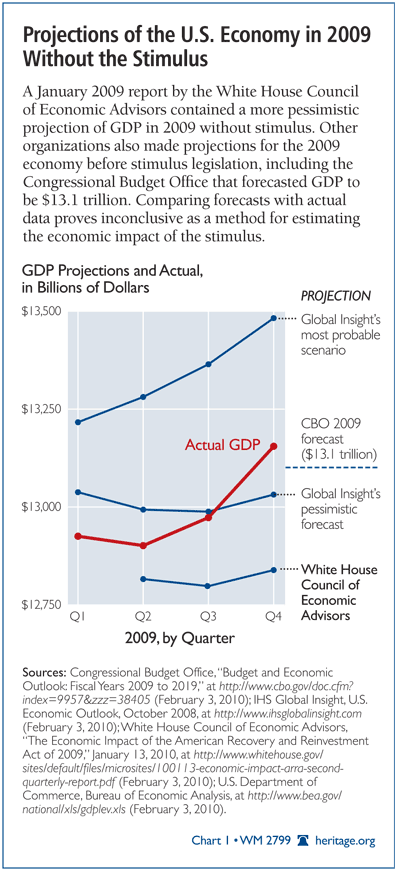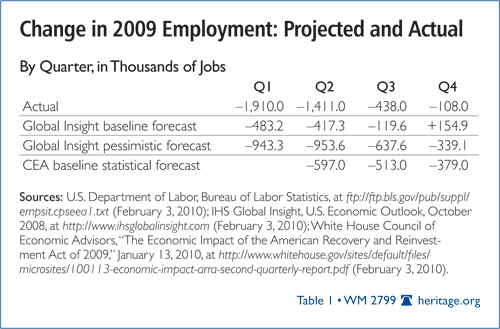The White House Council of Economic Advisers (CEA) published a report on the economic effects of the Administration’s economic stimulus plan.[1] The report claims that the stimulus legislation boosted gross domestic product (GDP) and employment above what they otherwise would have been. That is, the real results the economy is experiencing (10 percent unemployment, for example) are better than where the White House is now predicting the economy would have been without the fiscal stimulus.
However, the CEA’s proof of the economic impact of the fiscal stimulus policy fails basic standards of economic analysis.
Projected v. Actual
The CEA’s method, in brief, compared a statistical forecast of the economy based on historical patterns (no stimulus) with the actual economic results in 2009. On this basis, it claims that there are 2 million more jobs in the economy than otherwise would have been the case. The CEA then concludes that this difference between this statistical forecast and the actual results were the effect of the stimulus.
Yet the CEA’s benchmarks for unemployment and GDP numbers were completely arbitrary. If the Administration had used other economic forecasts, the results would not have been as impressive—in fact, some would have shown that the economy lost more jobs after the stimulus package was implemented.
One way to see the inadequacy of the CEA’s method is to compare it with other economic forecasts made for 2009—before details of the stimulus plan were known. These forecasts were done by companies and agencies that have a direct interest in making the most accurate forecast possible so that businesses and governments can plan accordingly.
Two comparable forecasts for 2009 were made by the non-partisan Congressional Budget Office (CBO), whose sole purpose is providing Congress with accurate budget forecasts, and IHS/Global Insight (GI), a private company that has been recognized as the most consistently accurate forecasting company in the world.[2]
GI’s assumptions for its most probable forecast scenario are similar to CBO’s. In late 2008, GI assumed that a decline in housing prices would remain a central issue. It projected housing markets continuing to struggle, causing home prices to fall 14 percent from the third quarter of 2008 to the second quarter of 2010.[3] Both CBO and GI predicted that inflation would continue to decline due to decreased demand for commodities in world markets and an overall world economic contraction.
GI also assumed that consumers would curb spending and that the Federal Reserve would continue to cut interest rates to spur lending and investment.
Although the assumptions for 2009 were similar, CBO and GI used different forecasting methodologies that led to fairly different results although all predicted a small expansion by the fourth quarter of 2009. The CEA, in constructing its statistical forecast, used yet another methodology.


It should be noted that this comparison exercise is not meant to legitimize the method of subtracting an economic forecast with actual data and attributing the difference to a specific set of policies. Rather, it is meant to show that this method provides inconclusive evidence of an effect and is therefore useless for answering the question of what economic impact the stimulus had in 2009. The Administration needs to do a rigorous dynamic economic impact study on the role the stimulus played in 2009.
The economic impact of the fiscal stimulus bill must be evaluated by projecting the economy without the stimulus bill and then introducing the fiscal stimulus to that same forecast. The CEA’s report constructs and then analyzes a forecast of a downward spiraling economy. It runs a “what if” scenario in the wrong direction. Rather than analyzing the economic impact of the fiscal stimulus on a benchmark forecast, the CEA constructs a forecast and benchmarks it to what actually occurred.
The True Impact of the Stimulus
The CEA claims that the stimulus bill created jobs in 2009, but this claim is based on its newly constructed “it would have been worse” forecast for 2009. When trillions of dollars are being spent, the American people deserve to have a true economic analysis done and should not waste money on meaningless reports.
Karen A. Campbell, Ph.D., is Policy Analyst in Macroeconomics in the Center for Data Analysis at The Heritage Foundation.

